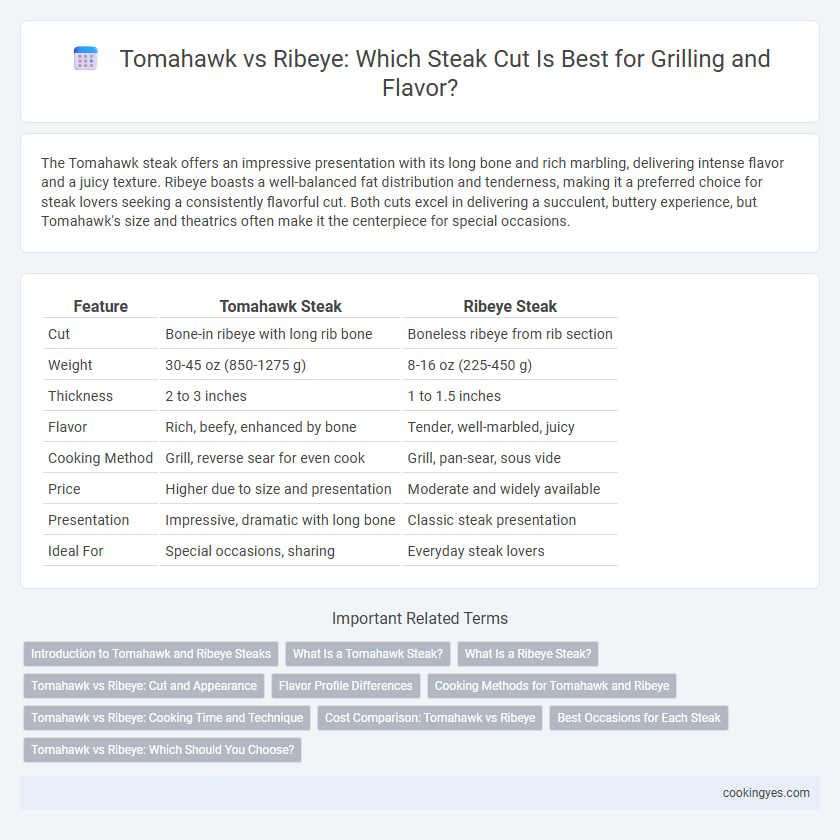The Tomahawk steak offers an impressive presentation with its long bone and rich marbling, delivering intense flavor and a juicy texture. Ribeye boasts a well-balanced fat distribution and tenderness, making it a preferred choice for steak lovers seeking a consistently flavorful cut. Both cuts excel in delivering a succulent, buttery experience, but Tomahawk's size and theatrics often make it the centerpiece for special occasions.
Table of Comparison
| Feature | Tomahawk Steak | Ribeye Steak |
|---|---|---|
| Cut | Bone-in ribeye with long rib bone | Boneless ribeye from rib section |
| Weight | 30-45 oz (850-1275 g) | 8-16 oz (225-450 g) |
| Thickness | 2 to 3 inches | 1 to 1.5 inches |
| Flavor | Rich, beefy, enhanced by bone | Tender, well-marbled, juicy |
| Cooking Method | Grill, reverse sear for even cook | Grill, pan-sear, sous vide |
| Price | Higher due to size and presentation | Moderate and widely available |
| Presentation | Impressive, dramatic with long bone | Classic steak presentation |
| Ideal For | Special occasions, sharing | Everyday steak lovers |
Introduction to Tomahawk and Ribeye Steaks
Tomahawk and Ribeye steaks both come from the rib section of the cow, prized for their rich marbling and robust flavor. The Tomahawk steak is distinguished by its long bone handle, resembling a tomahawk axe, which adds visual appeal and extra flavor during cooking. Ribeye steaks, boneless or bone-in, offer tender, juicy meat with a perfect balance of fat and muscle, making them a popular choice for steak lovers.
What Is a Tomahawk Steak?
A tomahawk steak is a bone-in ribeye known for its long, frenched bone resembling a tomahawk axe, typically weighing between 30 to 45 ounces. The extra-long rib bone adds visual appeal and enhances flavor by slowing cooking around the meat. Unlike a traditional ribeye, the tomahawk offers a larger presentation and is prized for its tenderness and rich marbling.
What Is a Ribeye Steak?
A ribeye steak is a premium cut sourced from the rib section of the cow, known for its rich marbling and tender texture. This cut offers a balance of flavor and juiciness due to the intramuscular fat, making it highly sought after by steak enthusiasts. Compared to the Tomahawk, the ribeye is typically boneless and more versatile for various cooking methods.
Tomahawk vs Ribeye: Cut and Appearance
The Tomahawk steak distinguishes itself by its long, frenched bone, creating a dramatic presentation that enhances its visual appeal, while the Ribeye is typically boneless or features a shorter bone, resulting in a more compact appearance. Both cuts come from the rib section, but the Tomahawk is essentially a Ribeye with an extended rib bone left intact, which contributes to its larger size and unique shape. The marbling and thickness of Tomahawk steaks often surpass standard Ribeye cuts, making it a favored choice for those seeking both flavor and impressive plating.
Flavor Profile Differences
Tomahawk steak offers a robust, beefy flavor with intense marbling that delivers rich, juicy bites, while ribeye is prized for its tender texture and well-balanced, buttery taste due to even fat distribution. The longer bone on the tomahawk enhances flavor during cooking by retaining heat and adding a smoky essence. Ribeye's finer marbling produces a smoother, less intense flavor profile, making it ideal for those seeking tenderness combined with savory richness.
Cooking Methods for Tomahawk and Ribeye
Tomahawk steaks require slower, indirect cooking methods like reverse searing to render their thick fat cap and achieve tender, juicy results, while ribeye steaks excel with high-heat, direct grilling or pan-searing for a flavorful crust. Both cuts benefit from resting after cooking to redistribute juices, but Tomahawks demand longer cooking times due to their size and bone-in structure. Sous vide techniques can also enhance tenderness and consistency for both steaks, allowing precise temperature control before finishing with a quick sear.
Tomahawk vs Ribeye: Cooking Time and Technique
Tomahawk steaks require longer cooking times due to their larger size and bone-in structure, often benefiting from reverse searing to ensure even doneness. Ribeye steaks cook faster and are suitable for high-heat grilling or pan-searing, delivering a rich marbling and tender texture. Mastering these techniques enhances flavor and tenderness, with Tomahawks demanding patience and Ribeyes offering quicker, consistent results.
Cost Comparison: Tomahawk vs Ribeye
Tomahawk steaks typically cost more per pound than ribeye due to their larger size and impressive presentation, often priced between $30 to $50 per pound compared to ribeye's $20 to $35 per pound. The cost premium for tomahawk includes the extended bone and visual appeal, making it popular for special occasions despite its higher price. Ribeye offers a more affordable option with similar marbling and flavor, providing a budget-friendly yet flavorful steak choice.
Best Occasions for Each Steak
Tomahawk steak, known for its impressive size and presentation, is ideal for special occasions and celebrations where visual impact and sharing are key. Ribeye steak, prized for its rich marbling and tenderness, suits everyday meals or intimate dinners, offering a flavorful experience without the need for elaborate presentation. Choosing Tomahawk enhances moments like holidays or steakhouse gatherings, while Ribeye fits perfectly with casual dining or quick gourmet meals.
Tomahawk vs Ribeye: Which Should You Choose?
Tomahawk and Ribeye steaks both offer rich marbling and intense beef flavor, but the Tomahawk stands out with its dramatic presentation and larger size, perfect for impressing guests or sharing. Ribeye delivers a more uniform thickness and easier cooking process, making it ideal for consistent doneness and quicker meals. Choosing between Tomahawk vs Ribeye depends on whether you prioritize show-stopping aesthetics and size or convenience and classic steakhouse texture.
Tomahawk vs Ribeye for Steak Infographic

 cookingyes.com
cookingyes.com